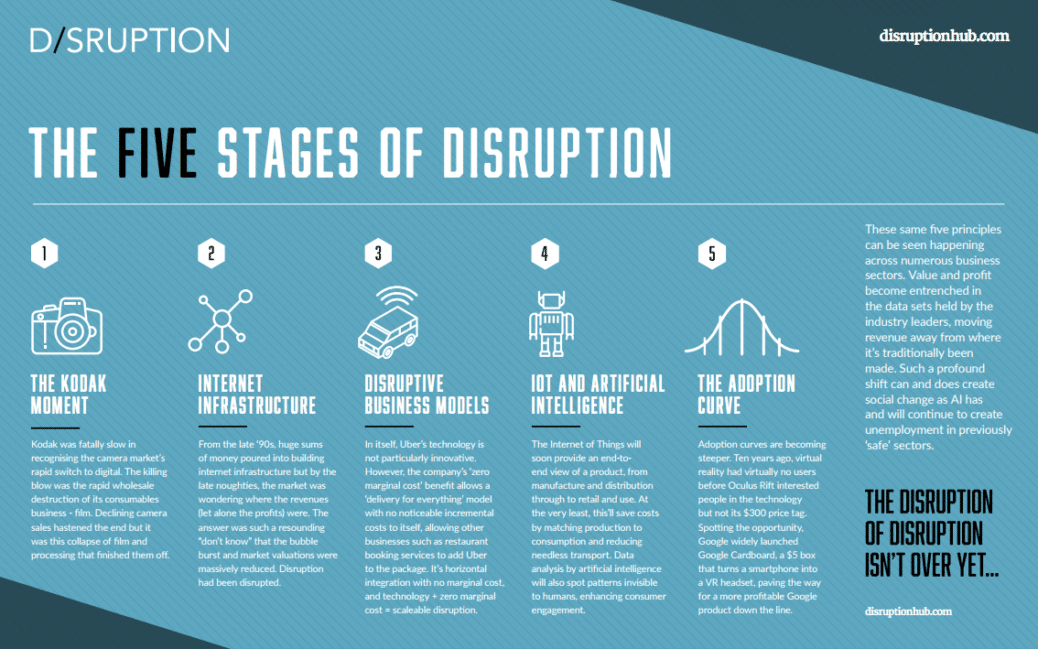Most people already know how Kodak was way too slow to recognise the camera market’s rapid switch to digital. The fatal blow to Kodak was the rapid wholesale destruction of its consumables business – film. Losing ground on camera sales certainly hastened the end but it was the collapse of film and processing that did it in.
copyright by disruptionhub.com
 From the late ‘90s onwards, huge amounts of money went into building internet infrastructure. But by the late noughties, the market started to ask where the revenues (let alone the profits) were. The answer was such a resounding “don’t know” that the bubble burst and the market valuation was massively reduced. In other words, disruption got disrupted.
From the late ‘90s onwards, huge amounts of money went into building internet infrastructure. But by the late noughties, the market started to ask where the revenues (let alone the profits) were. The answer was such a resounding “don’t know” that the bubble burst and the market valuation was massively reduced. In other words, disruption got disrupted.
Technology meets disruptive business models
Let’s take a look at Uber – a fabulous piece of user technology that marries drivers with passengers. In itself, that’s not particularly innovative… until you bring in the ‘zero marginal cost’ benefit. This allows Uber to use drivers in a ‘delivery for everything’ model with no noticeable incremental costs to itself. It costs the same to deliver anything, from customers and fast food, to parcels and even flu jabs. On its own, perhaps this is enough to give Fedex and UPS a Kodak moment, but it’s gone deeper than that. Uber recently bought out an API that allows other businesses to use Uber services. So currently in America, Opentable, an app for booking restaurant tables, includes Uber as part of the service so that booking a table automatically includes an Uber ride there and back. It’s horizontal integration with no marginal cost, and technology + zero marginal cost = scalable disruption.
Internet of Things and Artificial Intelligence
Imagine a business world where everything is connected. Everything. That’s raw materials to transport, to manufacturing, distribution, retail and the consumer, then beyond that to consumer engagement. The Internet of Things will enable all of that, providing an end-to-end view of the whole process in real time. At the very least, that’ll make savings at every step of the way. The world wastes $1 trillion of food every year but by real time analytics of production, transport and consumption, that could be reduced down to a few tens of millions. All made possible by the advanced understanding of real-time data through AI analytics.
read more – copyright by disruptionhub.com


Most people already know how Kodak was way too slow to recognise the camera market’s rapid switch to digital. The fatal blow to Kodak was the rapid wholesale destruction of its consumables business – film. Losing ground on camera sales certainly hastened the end but it was the collapse of film and processing that did it in.
copyright by disruptionhub.com
Technology meets disruptive business models
Let’s take a look at Uber – a fabulous piece of user technology that marries drivers with passengers. In itself, that’s not particularly innovative… until you bring in the ‘zero marginal cost’ benefit. This allows Uber to use drivers in a ‘delivery for everything’ model with no noticeable incremental costs to itself. It costs the same to deliver anything, from customers and fast food, to parcels and even flu jabs. On its own, perhaps this is enough to give Fedex and UPS a Kodak moment, but it’s gone deeper than that. Uber recently bought out an API that allows other businesses to use Uber services. So currently in America, Opentable, an app for booking restaurant tables, includes Uber as part of the service so that booking a table automatically includes an Uber ride there and back. It’s horizontal integration with no marginal cost, and technology + zero marginal cost = scalable disruption.
Internet of Things and Artificial Intelligence
Imagine a business world where everything is connected. Everything. That’s raw materials to transport, to manufacturing, distribution, retail and the consumer, then beyond that to consumer engagement. The Internet of Things will enable all of that, providing an end-to-end view of the whole process in real time. At the very least, that’ll make savings at every step of the way. The world wastes $1 trillion of food every year but by real time analytics of production, transport and consumption, that could be reduced down to a few tens of millions. All made possible by the advanced understanding of real-time data through AI analytics.
read more – copyright by disruptionhub.com
Share this: